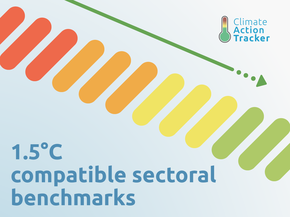Country summary
Overview
Chile has made considerable progress on climate action over the past few years following the enactment of the Framework Law on Climate Change in 2022. This is reflected in the rapid rate of renewables expansion and the coal phase-out plan going faster than anticipated. With this update, the CAT’s overall rating of Chile’s climate targets and actions has improved to “Almost sufficient”, one of the few countries to earn this rating.
The impact of Chile’s coal phase-out could be lessened, however, if it results in higher natural gas consumption from planned reconversions. Eight coal-fired units have yet to make a retirement commitment: they are not obliged to stop operating until 2040. The implementation of measures in the energy end-use and other sectors, transport in particular, has also been occurring at a slower pace than what is needed to meet Chile’s commitments under its climate target (NDC) and related policy documents.
According to our estimates, Chile's emissions have already peaked, in 2021, ahead of its 2025 commitment in the NDC. However, Chile will not be able to meet its 2030 NDC target under current policies. We project that emissions in the industrial processes, agriculture, and waste sectors will remain constant or slightly increase to 2030. While energy sector emissions will continue to decrease past 2030, rising energy demand and a potential increase in natural gas consumption in place of coal could result in only marginal emissions reductions.
Since our previous assessment, Chile has finalised its National Mining Policy 2050, which includes a target for the industry sector to reach carbon neutrality by 2040, in addition to zero fleet and renewable electricity objectives. New laws to promote renewable energy and address critical barriers like the lack of transmission lines, such as the Law on Energy Storage and Electromobility and the Energy Transition Law have been in the legislative process for a couple of years now.
Chile has also published new sectoral strategies to guide its short-term climate plans such as the Initial Agenda for the Second Phase of the Energy Transition, the Ministry of Energy’s Decarbonisation Plan, the Roadmap for the Advancement of Electromobility, as well as the Green Hydrogen Action Plan 2023–2030. Chile has outlined its short-term measures for promoting its green hydrogen industry and becoming a top exporter by 2040 and is in the process of piloting its domestically produced hydrogen bus by early next year.
Chile’s coal phase-out is well on track, with some units retiring faster than expected. More than 1.2 GW of coal capacity from 11 plants has been retired since 2019. Another nine plants have made commitments to retire or convert to natural gas by the end of 2025. This is in line with the Ministry of Energy’s Decarbonisation Plan target to retire or reconvert 70% of coal-fired units by the end of 2025, representing 3.6 GW in capacity. Gas must still be phased out in the short-term, however, and Chile should be careful when repurposing plants to avoid carbon lock-in and stranded assets. Recent scientific literature highlights that there is no room for investment in new oil, gas, and coal activities if global warming is to be limited to 1.5°C.
To accelerate its emission reductions to be aligned with a 1.5°C pathway, Chile could:
- Revive discussions on shifting the national coal phase-out date from 2040 to 2030 to mandate the remaining eight coal-fired plants that have not made firm retirement commitments to have a more ambitious retirement date.
- Decrease economic incentives for fossil fuels. Chile’s carbon tax is considered relatively ineffective due to its low carbon price, while diesel fuel is still subsidised for internal combustion engines (ICE).
- Implement concrete mitigation measures in the energy end-use, industry, agriculture, and waste sectors so that they can also contribute to emissions reductions leading up to 2030.
- Rapidly increase the pace of reforestation and sustainable forest management for Chile to meet its LULUCF commitments under its NDC and maintain the sector’s crucial status as a considerable sink. At the same time, Chile should avoid relying on increasing its LULUCF sink to meets its climate targets, given the high chance of carbon loss through deforestation or natural disturbance, and should instead prioritise emissions reductions in all other sectors.
Since our previous assessment, the positive developments in Chile’s climate policies include:
- Accelerating the pace of the coal phase-out since its initial announcement in 2019, with the Ministry of Energy announcing its intentions for 70% of coal plants to be retired or retrofitted by 2025.
- The Roadmap for the Advancement of Electromobility, which aims to address the infrastructure gaps that are hindering EV uptake.
- Chile has put a large focus on the just transition of the coal phase-out to promote job creation, new investments, and participatory planning in affected communities, including in the Ministry of Energy’s recent Decarbonisation Plan.
- Explicitly including a link between biodiversity and climate mitigation in its NDC.
Description of CAT ratings
The CAT rates each country’s targets and policies against (1) its fair share contribution to climate change mitigation considering a range of equity principles including responsibility, capability and equality, and (2) what is technically and economically feasible using modelled domestic pathways which, in absence of a better method, are based on global least-cost climate change mitigation.
Comparing a country’s fair share ranges and modelled domestic pathways provides insights into which governments should provide climate finance and which should receive it. Developed countries with large responsibility for historical emissions and high per-capita emissions, must not only implement ambitious climate action domestically but must also support climate action in developing countries with lower historical responsibility, capability, and lower per-capita emissions.
The CAT rates Chile’s climate targets and policies as “Almost sufficient”. This rating indicates that Chile’s climate policies and commitments are not yet consistent with the Paris Agreement’s 1.5°C temperature limit but could be with moderate improvements.
Chile is almost meeting its “fair share” contributions to climate change mitigation. Chile’s unconditional NDC is rated as “Almost sufficient” when compared to its fair share. Chile’s conditional NDC and policies and action are rated as “Almost sufficient” against modelled domestic pathways. To improve its rating, Chile could strengthen its climate policies and set slightly more ambitious conditional and unconditional NDC targets.
Chile’s current policies are "Almost sufficient" when rated against modelled domestic pathways. This rating indicates that Chile’s climate policies and action in 2030 are not yet consistent with the 1.5°C temperature limit but could be with moderate improvements. If all countries were to follow Chile’s approach, warming could be held below—but not well below—2°C.
Our 1.5°C modelled domestic pathway is based on global least-cost mitigation and defines the minimum level of emission reductions needed at home to be 1.5°C compatible. It should be taken as the floor, and not ceiling, for domestic ambition.
According to our assessment, emissions under Chile’s currently implemented policies would reach between 100–108 MtCO2e (excl. LULUCF) by 2030 (6–13% below 2021 levels, when emissions peaked). This emissions level is also insufficient to reach both the conditional and unconditional 2030 NDC targets (88–95 MtCO2e). Chile needs to implement additional policies in order to be 1.5° compatible.
Since our previous assessment, Chile has continued to shut down coal plants according to its phase-out plan. Over 1.2 GW of coal capacity from eleven plants has been retired since 2019 and an additional nine units have committed to retire or convert to natural gas between 2024 and 2025. Up to five of these units are expected to be retrofitted for gas.
While considered a “transition fuel” by the Chilean government, fossil gas is still a fossil fuel that the CAT estimates needs to be completely phased out by 2035 to remain on a global 1.5°C pathway, so Chile must be careful when repurposing its coal-fired plants to gas, as this could create either a carbon lock-in - or a risk of being left with stranded assets.
While there were discussions around bringing forward the coal phase-out year to 2030, it has not been mentioned for some time and recent policy documents reference the 2040 phase-out date. An early coal phase-out, where electricity generation is replaced by renewable sources rather than fossil gas, would significantly impact Chile’s current policies pathway and bring it considerably closer to a 1.5°C trajectory and be aligned with CAT’s power sector benchmarks.
The transport sector makes up a significant share of Chile’s total GHG emissions, especially as its energy consumption continues to increase. The Electromobility Strategy, Energy Efficiency Law, and ban on ICE cars by 2035 are key policies expected to accelerate the low-carbon transportation transition, but Chile’s EV sales have yet to exceed 1%. More should be done to encourage EV uptake and decrease energy demand in the sector, for instance reforming diesel fuel subsidies and a modal shift in transportation, so that Chile does not fall behind on its transport electrification targets.
Maintaining the LULUCF sink is an important component of Chile’s climate targets which is threatened by the increased frequency and severity of wildfires related to climate change. While Chile has ambitious commitments for reforestation and sustainable forest management in its NDC, the pace of implementation has been far too slow, and stronger policies to support reforestation and forest management are needed.
Full policies and action analysis can be found here.
We rate Chile’s 2030 conditional NDC target – a reduction of up to 45% in net emissions from 2016 values by 2030, subject to international support– as “Almost sufficient” when compared with modelled domestic emissions pathways. This rating indicates that Chile’s conditional NDC target in 2030 is not yet consistent with modelled domestic pathways limiting warming to 1.5°C but could be, with moderate improvements.
If all countries were to follow Chile’s approach, warming could be held below—but not well below—2°C.
To improve its rating and be consistent with the 1.5°C temperature limit, Chile could lower the 2030 target by 21 MtCO2e to reach an absolute emissions limit of 69 MtCO2e excl. LULUCF in 2030 and, if necessary, outline the international support that it would need to achieve it.
While Chile does not explicitly ask for international finance, the NDC states that the 45% reduction target is conditional on specific financial, markets, technological and political conditions. On balance, however, the CAT methodology shows that provision of a small amount of international support is consistent with the wide range of literature on fair share contributions to meeting the Paris Agreement’s goals. Our methods do not provide a clear answer regarding the need for climate finance for Chile.
We rate Chile’s 2030 unconditional NDC target – the absolute emissions target of 95 MtCO2e excluding LULUCF in 2030 – as “Almost sufficient” when compared to its fair-share contribution to climate action. This rating indicates that that Chile’s unconditional target in 2030 not yet consistent with its fair share of the global mitigation effort to limit warming to 1.5°C but could be, with moderate improvements. If all countries were to follow Chile’s approach, warming could be held below—but not well below—2°C.
The NDC target rating has changed from “Insufficient” to “Almost sufficient” from our previous update. However, this change is due to a literature update to our fair share (FS) ranges, which aligns our equity approaches with international environmental law (Rajamani et al., 2021) and therefore excludes studies based on cost-effectiveness; we also included additional studies to reflect the latest research available in the field. The change of ratings does not represent improved climate ambition compared to our previous assessment.
Chile has large forested areas, and although emissions have fluctuated strongly, e.g. because major wildfires swept across the country in 2017, Chile’s LULUCF sinks over the last 20 years absorbed, on average, roughly two-thirds of total emissions. Chile should work toward maintaining this LULUCF sink, but it is far from meeting its ambitious reforestation and sustainable forest management commitments in its NDC. For more information about forestry activities in Chile, please see the LULUCF tab under Policies and Actions.
We evaluate Chile’s net zero target as “Acceptable”. Chile’s currently proposed net zero target for 2050 covers most key elements and is now also legally binding through the framework law. Chile’s target covers all sectors and gases, communicates strategic goals and emissions targets per sector, and provides a detailed methodological framework. Notably, Chile underpins these sector-specific ambitions with detailed emissions pathway analyses.
Chile plans to heavily rely on negative emissions by forests to reach its net zero target, expecting carbon sinks to contribute as much as 50% of the emissions reduction required to reach the 2050 neutrality goal (Gobierno de Chile, 2021).
It is therefore extremely important to assure that forests keep acting as sinks and do not turn into emission sources, a risk that can only partly be mitigated by policies, as not only human activity but natural factors, and increasingly the effects of climate change via more extreme and frequent heat waves, droughts, and wildfires, can turn removals from LULUCF to emissions. While Chile does not actively outline any plans to rely on reductions and removals outside its borders, future iterations of its NDC could explicitly rule out international credits to make this clearer.
Further analysis
Latest publications
Stay informed
Subscribe to our newsletter





